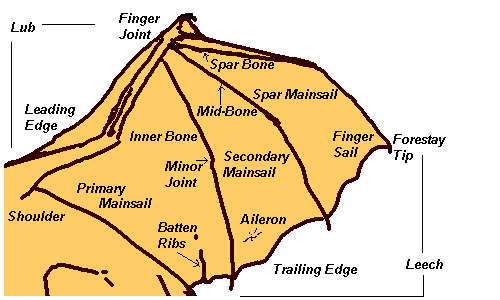The Dragon's Wings
| General | Anatomy | Terms |
General
-
Dragons can fly as soon as their wings are dry, but to prevent injury they aren't allowed to fly until one Turn old.
-
The wingspan is usually 1 and 2/3 the length of the dragon.
-
As dragons age, their finger tip and elbow joints harden, making maneuvers difficult, but gliding is possible since that's done with the shoulder.
Anatomy
Many of the descriptive and anatomical terms used in the discussion if the wing repair are familiar to any Sea Holder, for the wing functions in much the same manner as a ship's sails; so similar titles are applied. Likewise, Healers will recognize many of the orthopedic terms as the same ones applied to humans. In spite of the different planetary origin, much of the bone and muscular arrangement of dragons is similar to that of humans and animal.
About half the length of a dragon wing is supported by the armlike bones (complete with elbow) between the shoulder and the finger joint, the structure which includes the bones found in a human's writs and hand without the fingers. The massive strength h of the shoulder and upper arm muscles supply the greatest "lift" of the dragon. The elbow has a slightly flexed position, and a membrane stretches between the shoulder and finger joint forming the leading edge.
The finger joint includes the metacarpus, the vestigial "thumb", and the joints for all the wing bones. The extensor and flexure muscles which originate below the elbow narrow into long tendons just before reaching the finger joint, and these extend all along the wing bones, attached at each successive join for fine control of the wing tips.
The first two wing bones run almost together, as the bones form the outer "spar" portion of the lub. The remaining two wing bones fan out from the finger joint. The inner bone is almost perpendicular to the spar bone, and ends about midway between the body and the forestay finger tip.
Originating at the dorsal spine of the back, and stretching to the inner bone, is the largest of three vast membranes -- the main wingsails. The primary wingsail must support the bulk of the dragon's weight. The two lesser sails run from inner bone to midbone, and midbone to spar bone. They are also vital for support, bye are equally important for maneuverability. Both axes of the wing can be altered by the flexion of the various joints. The tip of the spar mainsail can function almost independently, and thus is called the finger sail. Due to the sheer bulk of the mainsails, additional support is provided by cartilaginous battens which extend from the arm and finger joint to the leech or trailing edge.

Terms
Aileron: The sections and membranes which make up the mainsails.
Batten Rib:
Cartilage ribs within the mainsails, joining sections of aileron to other ribs as well as the different bones/body.
Bones: The wing has 4 major bone groups, each made up of 3 sections. (Inner Bone, Mid-bone, Spar bones, and Outer bone).
Finger joint:
An extra bone which protrudes from the "hand" of the dragon from the same point the other bone sections merge.
Finger sail:
The section of the spar mainsail which reaches diagonally from the lowest minor joint of the spar bone to the trailing edge.
Leading Edge:
The top cartilage of the wing.
Leech:
The whole lower edge of the wing, from the body to the forestay tip.
Lub:
The whole upper edge of the wing, from shoulder to forestay tip.
Mainsail:
The wing has 3 mainsails, each made up of aileron and batten ribs (primary mainsail, secondary mainsail, spar mainsail).
Trailing Edge:
The lower cartilage of the wing.
All references to worlds and characters based on Anne McCaffrey's fiction are copyrightę Anne McCaffrey 1967,2000, all rights reserved, and used by permission of the author.
The Dragonriders of Pern« is registered U.S. Patent and Trademark Office, by Anne McCaffrey, used here with permission. Use or reproduction without a license is strictly prohibited.
Last Updated: 1 January 2002
This site maintained by [email protected]
Based on an earlier work by [email protected] of Star Stones' Dragonhealing
This page hosted by  Get your own Free Home Page
Get your own Free Home Page